How Are Diamonds Made? Natural vs Lab-Created Explained
Two Paths, One Diamond Not all diamonds come from the same place — but they all start the same way. Pure carbon, crystalized under immense pressure and heat. Whether it…
In the world of lab-grown diamonds, choosing the right certification is crucial for ensuring the quality and authenticity of your purchase. Two prominent gemological laboratories, the International Gemological Institute (IGI) and the Gemological Institute of America (GIA), issue certifications for lab-grown diamonds. This article will explore the differences between IGI and GIA lab-grown diamond certifications, exploring the importance of diamond grading reports and certification, factors to consider when selecting a diamond, and the pros and cons of each certification.
Diamond grading reports serve as a blueprint for a diamond’s characteristics, providing information on its cut, color, clarity, and carat weight. Certification, on the other hand, is an official document issued by a reputable gemological laboratory confirming a diamond’s authenticity and quality. These reports are essential for consumers, helping them make informed decisions when purchasing diamonds.
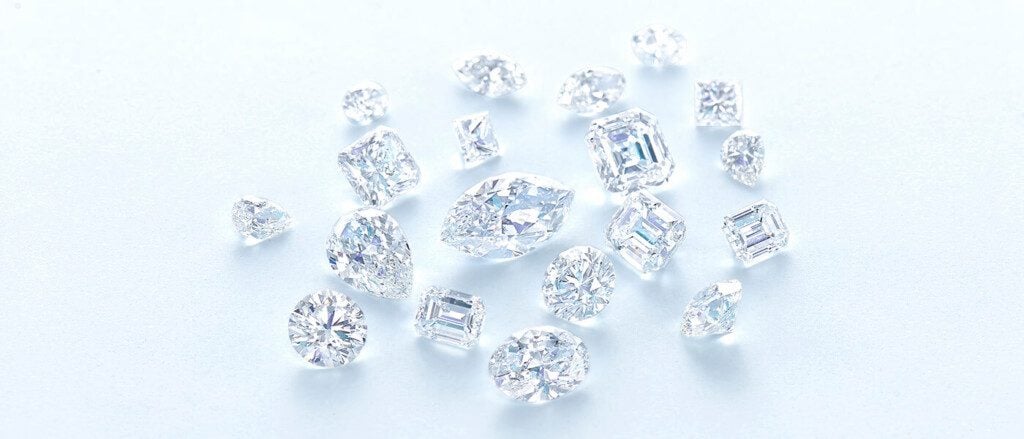
Image Source: Kwiat
Before going into certification specifics, it’s essential to understand what to look for in a diamond. The “Four Cs” – cut, color, clarity, and carat weight – play a pivotal role in determining a diamond’s quality. The cut influences the diamond’s brilliance, color refers to the absence of color, clarity assesses the presence of flaws or inclusions, and carat weight measures the diamond’s size.
Shop Lab-Grown Diamonds: Some of our vetted vendors offer lab-grown diamonds – both loose or set in finished jewelry. Check out Whiteflash and their A CUT ABOVE lab-grown diamonds, and James Allen's extensive online collection.
The Gemological Institute of America (GIA) stands as the foremost authority in diamond grading and gemological research. GIA’s commitment to maintaining the highest standards has solidified its reputation as the gold standard in the diamond industry. Here’s a closer look at why GIA certified diamonds are widely regarded as a mark of excellence:
GIA certifications are universally recognized and respected across the globe. Established in 1931, the institute has played a pivotal role in shaping industry standards and practices. Its certifications are trusted by consumers, jewelers, and industry professionals alike, providing a sense of confidence in the authenticity and quality of the diamonds it grades.
GIA employs a comprehensive and meticulous grading process. The institute’s experts assess diamonds based on the Four Cs – cut, color, clarity, and carat weight – using precise methodologies and state-of-the-art technology. GIA’s stringent standards ensure consistency and accuracy, offering a reliable benchmark for evaluating the quality of diamonds.
A GIA diamond grading report provides a wealth of information about the diamond’s characteristics. From precise measurements of proportions to detailed information about inclusions and blemishes, GIA certifications offer transparency and clarity. The report becomes a valuable tool for consumers, aiding them in making informed decisions based on their preferences and priorities.
GIA is not only a certifying body but also a leader in gemological education and research. The institute has contributed significantly to the understanding of diamonds, gemstones, and their characteristics. This commitment to ongoing research ensures that GIA remains at the forefront of industry knowledge, allowing it to continually refine and update its grading standards.
GIA certifications have a profound impact on the diamond market. Diamonds with GIA certification often command higher value in the market due to the institute’s reputation for accuracy and integrity. Additionally, many insurance companies and appraisers rely on GIA certifications when determining the value of a diamond.
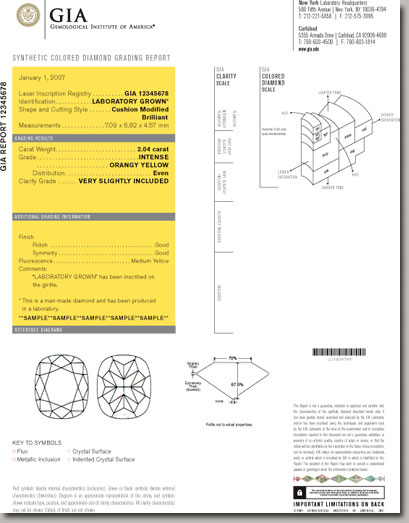
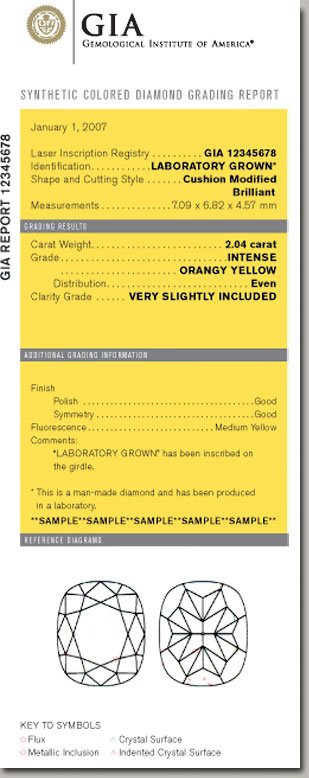
An example of a GIA Lab-Grown Diamond Grading Report. Image Source: Whiteflash
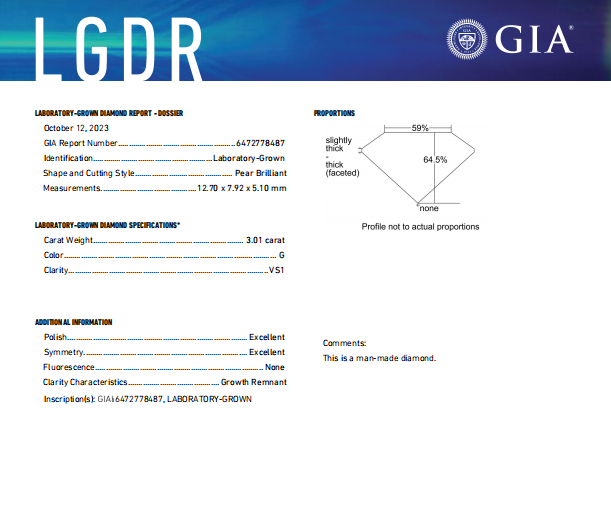
Image Source: Whiteflash
While GIA certifications are widely regarded as the gold standard, it’s essential to consider potential drawbacks:
GIA-certified diamonds typically come with a higher price tag compared to diamonds certified by other laboratories. The thoroughness of the GIA grading process contributes to the increased cost.
Due to the meticulous nature of GIA’s grading process, obtaining a GIA certification may take longer than certifications from other laboratories. This extended processing time can be a consideration for those seeking a quicker purchase.
GIA-certified diamonds are synonymous with quality, accuracy, and trust in the diamond industry. While the cost and processing time may be factors to consider, many consumers prioritize the assurance that comes with a GIA certification, making it a preferred choice for those seeking the highest standard in diamond grading.
Shopping for premium lab-grown diamonds? Discover a range of choices, from loose diamonds to finished jewelry, through our reliable vendors. Explore renowned retailers such as Whiteflash, James Allen, and Adiamor, all offering a broad array of certified lab-grown diamonds accessible online.
The International Gemological Institute (IGI) has established itself as a reputable gemological laboratory, offering certifications for diamonds, including lab-grown diamonds. While not as old as some other institutions, IGI has gained recognition for its efficiency and widespread acceptance. Here’s a closer look at the key aspects of IGI certified diamonds:
One of the primary advantages of IGI certifications is their cost-effectiveness. Compared to some other laboratories, obtaining an IGI certification may be more budget-friendly. This makes IGI an attractive option for those seeking quality assurance without the premium associated with certain certifications.
IGI is known for its relatively quick turnaround time in issuing certifications. This efficiency can be appealing to buyers who are looking to make a purchase promptly. The quicker processing time allows for a more streamlined diamond buying experience.
IGI certifications are widely accepted in the jewelry industry. The institute has earned a solid reputation for its commitment to accuracy and reliability in grading diamonds. Many jewelers and consumers alike recognize IGI as a trusted source for diamond certifications.
IGI employs a comprehensive grading process to evaluate diamonds, considering factors such as cut, color, clarity, and carat weight. While some may perceive IGI standards as slightly more lenient than certain other institutions, the institute maintains a commitment to providing accurate and detailed assessments.
IGI incorporates modern technology into its grading processes. This includes advanced tools and equipment for precise measurements and assessments. By staying current with technological advancements, IGI ensures that its certifications align with industry standards.
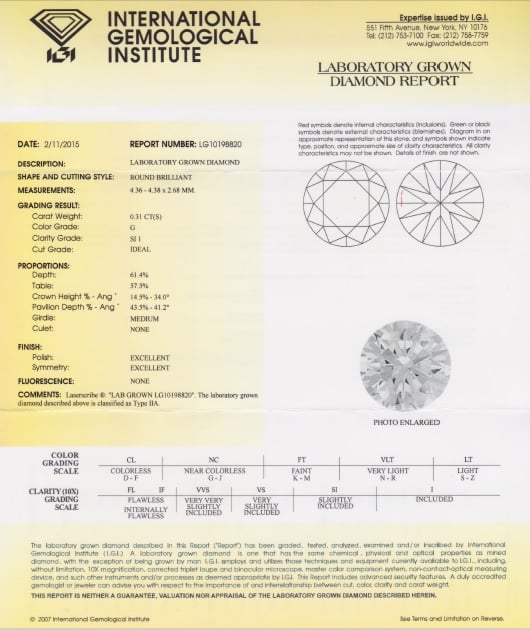
An example of an IGI Lab-Grown Diamond Grading Report. Image Source: Beyond 4Cs
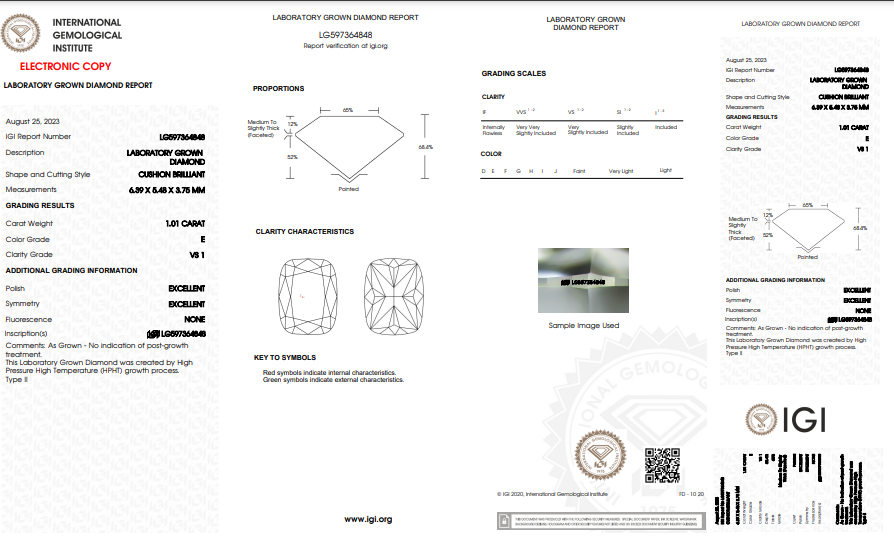
Image Source: Whiteflash
While IGI certifications offer various advantages, it’s essential to consider potential drawbacks:
Some industry and consumer base individuals perceive IGI standards as slightly more lenient than those of other well-established laboratories. This perception can influence the perceived value of IGI-certified diamonds.
While IGI certifications are widely accepted, there may be some variability in global recognition compared to other institutions with more extensive histories. Buyers should know the specific preferences and requirements within their local markets.
IGI-certified diamonds present a compelling option for those seeking a reliable and cost-effective certification. The institute’s commitment to accuracy, efficiency, and innovation has contributed to its widespread acceptance in the diamond industry. Buyers should weigh the pros and cons based on their priorities and preferences when choosing between IGI and other certification options.
While the International Gemological Institute (IGI) is well respected for its grading of lab-grown diamonds, it’s important to note that its reputation for grading natural diamonds may not be as consistent or widely recognized. The institute has gained prominence for its efficiency and accuracy in evaluating lab-grown diamonds, but there may be variability in the reliability and acceptance of its grading standards for natural diamonds. Therefore, when considering IGI certification for lab-grown diamonds, buyers should be aware of this distinction and prioritise certifications specific to lab-grown diamonds for the most reliable assessment of quality and authenticity.
Certified diamonds provide consumers with an assurance of quality, authenticity, and accurate information about the diamond’s characteristics. In the absence of certification, buyers may be at risk of purchasing misrepresented or inferior diamonds. Certification is an invaluable tool for comparing diamonds and making an informed choice based on individual preferences and budget.
WATCH: Lab Diamond Certificates GIA vs IGI, Learn What is the Best Diamond
The choice between a GIA or IGI certified diamond depends on individual priorities. If global recognition and the highest level of accuracy are paramount, a GIA certification may be the preferred option despite the associated higher cost and longer processing time. On the other hand, if cost-effectiveness and a quicker turnaround are priorities, an IGI certification could be a suitable choice, with the understanding that standards may be perceived as slightly more lenient.
If you're looking to purchase lab-grown diamonds, we recommend exploring the selections available from our carefully vetted vendors.
In addition to certification from reputable gemological laboratories like the International Gemological Institute (IGI) and the Gemological Institute of America (GIA), diamond imaging and high-definition (HD) video play a crucial role in evaluating and selecting the perfect lab-grown diamond. Here’s why:
Diamond imaging, including high-quality photography and HD video, provides a detailed visual representation of the diamond. This allows buyers to scrutinize the diamond’s characteristics, including its cut, color, clarity, and overall appearance, with precision and clarity. HD video, in particular, offers a dynamic view of the diamond from various angles, providing a comprehensive understanding of its visual appeal.
By offering transparent and detailed views of the diamond, imaging and HD video instill confidence in buyers. They can assess the diamond’s beauty and authenticity firsthand, mitigating any concerns about misrepresentation or undisclosed flaws. This transparency fosters trust between buyers and sellers, ensuring a satisfactory purchasing experience.
Imaging and HD video empower buyers to make informed decisions based on their preferences and priorities. They can closely examine the diamond’s features and compare them against their desired criteria, such as cut quality and visual appeal. This enables buyers to select a diamond that aligns perfectly with their preferences and budget.
Diamond imaging, particularly with advanced tools like Angular Spectrum Evaluation Technology (ASET), allows for the evaluation of light performance. ASET images reveal how light interacts with the diamond, showcasing aspects such as brightness, contrast, and light leakage. This information is invaluable in assessing the diamond’s brilliance and fire, enhancing the overall buying experience.
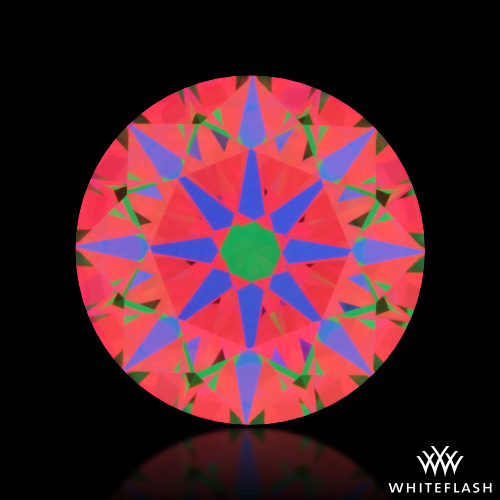
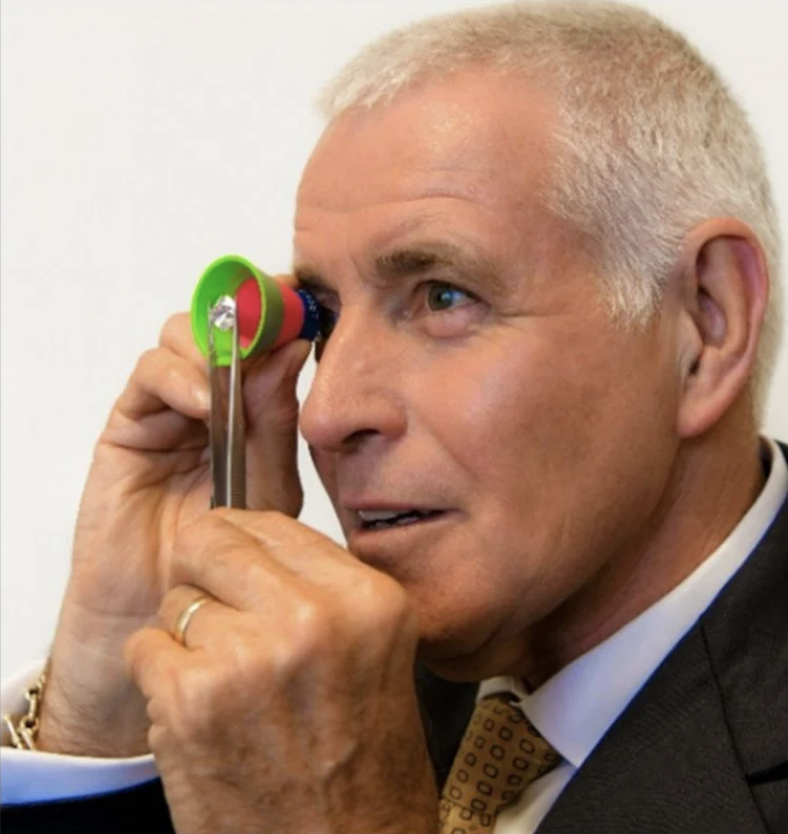
Hearts and Arrows Ideal Cut DiamondASET Image (Image Source: Whiteflash)
Garry Holloway, Founder of Holloway Diamonds and ‘CutNut’ on the PriceScope Forum
Incorporating imaging and HD video into the diamond evaluation process reinforces the assurance of quality. Buyers can verify the diamond’s characteristics and ensure that it meets their expectations before making a purchase. This proactive approach minimizes the risk of dissatisfaction and enhances confidence in the chosen diamond.
In summary, diamond imaging and HD video complement certification from esteemed gemological laboratories like IGI and GIA by providing enhanced visual assessment, transparency, and confidence. They facilitate informed decision-making, enable evaluation of light performance, and assure the quality of the selected lab-grown diamond. Embracing these technologies empowers buyers to make educated choices and acquire diamonds that meet their exacting standards.
Selecting the right certification for a lab-grown diamond is a crucial step in the buying process. Both GIA and IGI certifications offer reputable assessments of a diamond’s quality, and the choice ultimately depends on the buyer’s preferences, budget, and time constraints. Regardless of the certification chosen, the key is to prioritize transparency, quality, and accuracy to ensure a satisfying and informed purchase.

Retail Diamond Prices Chart Updated Monthly.

Two Paths, One Diamond Not all diamonds come from the same place — but they all start the same way. Pure carbon, crystalized under immense pressure and heat. Whether it…
A Wedding Ring as Unique as Your Love Finding the right wedding ring isn’t just about diamonds or gold – it’s about finding the one that feels right. With hundreds…
So, you’re thinking about lab-grown diamonds? Smart move. They’re just as sparkly as the natural kind but usually cost less. But where do you actually go to buy them? It…

Want to stay updated on the most recent blogs, forum posts, and educational articles? Sign up for Bling News, PriceScope’s weekly newsletter.